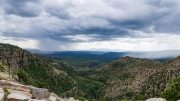According to the National Weather Service, Colorado’s annual Monsoon Season is running a bit late this year, but it is definitely on its way.
The word “monsoon” refers to the seasonal shift in the wind direction. In Colorado, that leads to stormy weather during July and August. An area of low pressure builds over the Desert Southwest that draws up moisture from the Pacific Ocean. In addition, a ridge of high pressure to the east pulls in moisture from the Gulf of Mexico.
The annual North American Monsoon is basically a pattern of increased thunderstorms and rainfall activity across the southwestern United States. During Monsoon Season, thunderstorms are fueled by daytime heat and build up during the late afternoon. Typically, these storms dissipate overnight, and the next day starts out fair, with the cycle repeating.
So, does “Monsoon Season” just mean that we have daily afternoon thunderstorms? Well… yes. But it can also lead to something far more dangerous.
The National Park Service warns that thunderstorms with heavy rain can cause severe flooding in canyons and along area burn scars during Monsoon Season. These storms can be powerful and sudden, causing water to rise quickly downstream from heavy rain, even when the parent thunderstorm is miles away. Several of Colorado’s most destructive floods, including the state’s deadliest natural disaster, occurred during Monsoon Season.
On July 27th and 28th, 1997, Fort Collins and surrounding area received nearly 14.5 inches of rain. In one 90-minute span, about 6 inches of rain fell, marking the heaviest rain ever recorded in a Colorado urban area. The flood killed five people, injured 54, destroyed 200 homes and caused more than $200 million in property damage.
The flood of September 2013 ranks among the worst natural disasters in Colorado history. It happened when a storm system stalled over the Front Range on September 9th, 2013, dumping nearly the equivalent of a year’s worth of precipitation over five days. Parts of Fort Collins saw 12 inches of rain. The flooding killed nine people, damaged or destroyed an estimated 2,000 homes and ripped up many roads in Larimer, Boulder and Weld counties. Among the heavier casualties was U.S. Highway 34 — the gateway to Rocky Mountain National Park — which saw 86% of the road destroyed. It took nearly five years and $300 million to repair the damages.
During Monsoon Season it’s a good idea to keep an eye on the sky, pay attention to weather forecasts, and check your smartphone weather app before heading into the mountains. As history has shown us, monsoon generated flash floods are infrequent, but when they strike, they can be lethal.
Weather experts suggest hitting mountain trails early in the day and be off exposed mountain peaks early. Know the easiest route back to your car. If flash flooding does happen, head to higher ground.
- Sunday, January 21st Weather - January 21, 2024
- Saturday, January 20th Weather - January 20, 2024
- Ark-Valley Humane Society Pet of the Week: Azula - January 17, 2024





Be the first to comment on "Colorado’s Monsoon Season Is a Little Late This Year"